
By Corregio, 1494-1534 (Louvre.)
Sacred Texts Journals Christian Articles
A MONTHLY MAGAZINE
 |
| THE MYSTICAL MARRIAGE. By Corregio, 1494-1534 (Louvre.) |
Frontespiece to the Open Court
BY THE EDITOR.
IF a distinction is made between Jesus and Christ, we mean by Jesus the man, while Christ denotes the office and dignity claimed for Jesus. Jesus lived about nineteen hundred years ago in Palestine,
 |
| THE MARRIAGE OF ST. CATHERINE. By Previtali (15th cent.). In the Church of San Giobbe at Venice. |
and he was a Galilean of Jewish descent, while Christ is the God-man, the realization of human perfection, the highest ideal of religion.
The basis of our Christ-conception is, first, the Gospel tradition of the character of Jesus, and for certain reasons (into which we need not enter here) we deem the nucleus of it, mainly represented by Mark, historical. There have been incorporated into the Gospel stories, however, certain traits of Christ-conceptions which are older than Jesus. They are ancient reminiscences of saviours, of divine heroes, of God-men, of mediators between God and mankind, of God-incarnations, etc., and from the beginning these notions crystallized with great exuberance around the figure of the Crucified.
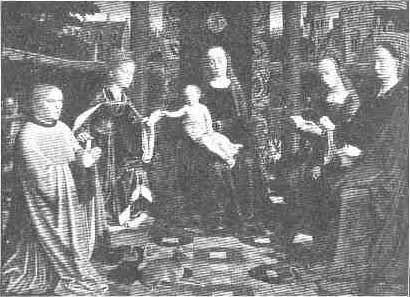 |
| By David (Gheeraert), d. 1523. In the National Gallery at London. On the right are St. Barbara with a book and Mary Magdalene with ointment, and on the left the donor, Richard van der Capelle. |
Now it is a characteristic feature of some pagan saviours that when they have conquered the enemy they enter in triumphal procession and celebrate their marriage feast. This is especially the case of Bel Marduk,1 the main mediator god of ancient Babylon, who in the faith of his worshipers bears, in many respects, a close resemblance to the Christ of Christianity.
Since Christianity was tinged with ascetic sentiments especially in the beginning, the marriage idea of Christ has been considerably dimmed, but it was not entirely lost sight of. Not only have we p. 451 references in the parables of Jesus which state that the kingdom of Heaven is like unto a marriage (Matt. xxii. 1-14) and men's expectancy of salvation is compared to the wisdom or folly of virgins who wait for the bridegroom (Matt. xxv. 1-13),2 but St. Paul calls the Church definitely the "Bride of Christ" (2 Cor. xi. 2; Eph. v. 24-32), and St. John the Divine repeatedly speaks of the bride and the marriage of the Lamb. The bride is Jerusalem representing the Church and the Lamb is Christ.
 |
| THE MARRIAGE OF THE LAMB. By Schnorr von Karolsfeld. |
St. John the Baptist, when announcing Jesus, calls himself the friend of the bridegroom, but he is not the Christ. John declares "he that hath the bride is the bridegroom" (John iii. 29), implying therewith that Jesus and not he himself is the Messiah, and Christ does not request his disciples to fast, as stated by Mark3 (ii. 19):
"And Jesus said unto them, Can the children of the bride-chamber
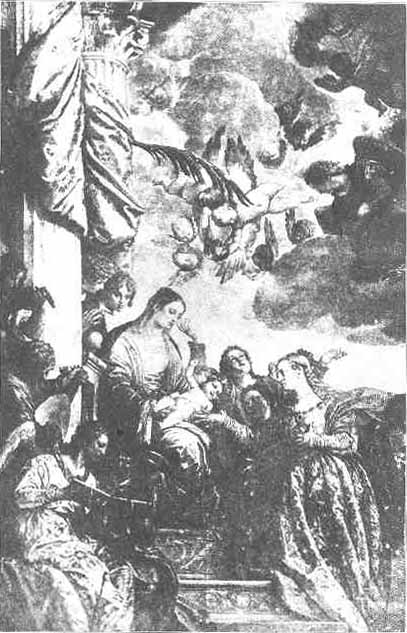 |
| THE MARRIAGE OF ST. CATHERINE by Paul Veronese, 1528-1588. In the Church of St. Catherine at Venice. |
p. 453 fast, while the bridegroom is with them? as long as they have he bridegroom with them, they cannot fast."
These several scattered references to the Saviour as a bridegroom
 |
| By Tintoretto, 1518-1594. In the Ducal Palace at Venice. |
appear in a new light when compared to the bridal festivities of pagan saviours which were celebrated in the ancient Orient and were also not unknown in Egypt and in Greece. We can not doubt p. 454 that here, as in many other customs, Babylonian traditions must have exercised avery powerful influence upon the formation of religious ideas in Judea.
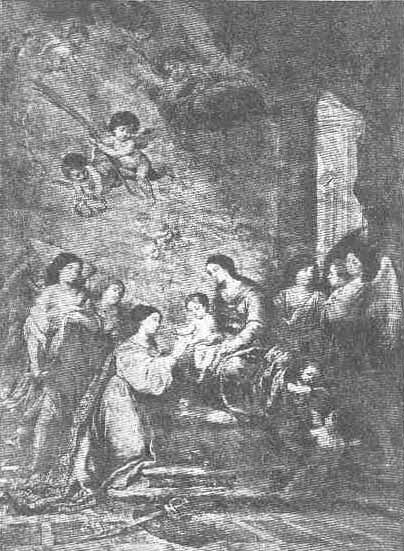 |
| By Murillo, 1618-1682. (Cadiz.) This was the artist's last production. |
Marduk is in more than one respect comparable to Christ. He is the beloved Son of Ea, the God of Heaven, by whom he is addressed in these words: "My son, what is it that thou dost not p. 455 know! What then could I still teach thee! What I know thou knowest also!"4
Marduk, the conquerer of Tiamat, the monster of the deep, is Ea's vicegerent on earth; he is king of gods and men, and he is the
 |
| By Giuliano Bugiardini, 1475-1554. In the Pinapothek at Bologna. |
incarnation of divine wisdom. He is the saviour god, and the saviour king with whose arrival the Golden Age begins on earth. But the most remarkable parallelism obtains between Marduk and Christ in that both rise from the dead and the festival of resurrection p. 456 is celebrated for each in the beginning of the natural year in the spring.
Little is known of Marduk's death, but that he died and descended into the nether world appears from the fact that he bears the name Bel nubatti, "Lord of lamentation" (or as Schrader translates it, "Herr der [Toten-]Klage"), suggesting the assumption that his death was lamented in a similar way as the death of Adonis or other vegetation and solar deities. We further know from Greek sources5 (Ctesias XXIX, 21 f.; Ælianus, Var. Hist.) that Xerxes opened and plundered the tomb of Bel, which can only mean the transference of the god's statue from Babylon to some other place, and proves that the temple of Bel contained the tomb of the god, thus implying that there was an annual day of lamentation for his death.
The Easter festival of Bel coincides with the New Year's day of Babylon, the first of Nisan, and was celebrated under the name
 |
| WEDDING PROCESSION OF DIONYSUS AND ARIADNE. A Sarcophagus in the Glyptothek at Munich. |
tabū, which Jensen translates by "resurrection" in the sense of the Christian Epiphany. It was the main religious festival of Babylon and in a description of it we read of Marduk: ihis ana hadassutu, "he hastens to wedlock." (Schrader translates, "er eilte zur Brautschaft.") His bride is called Tsarpanitu, which is commonly assumed to be a cognomen of Istar.
Similar festivals have been celebrated in other cults, e.g., the wedding of Zeus with Hera, of Dionysus with Ariadne, of Eros with Psyche, etc.
Bel Marduk was replaced among the Persians by Mithras who succeeded to all the honors of the Babylonian god, and in the days of Christianity Christ replaced both.
In Revelations which preserves a more primitive conception of Christ than the Gospels, and contains more reminiscences of ancient p. 457 Babylon (as Gunkel has proved) than any other book of the New Testamenent, we read of the marriage feast of the Lamb (xix. 7-9):
"Let us be glad and rejoice, and give honor to him: for the marriage of the Lamb is come, and his wife hath made herself ready. And to her was granted that she should be arrayed in fine linen, clean and white: for the fine linen is the righteousness of saints. And he saith unto me, Write, Blessed are they which are called unto the marriage supper of the Lamb. And he saith unto me, These are the true sayings of God."
We must remember that the lamb is the New Testament emblem for Christ corresponding to Bel Marduk whose symbol is the ram or male sheep, corresponding also to the ram of Amen Ra. Alexander the Great had a coin struck which pictured him with the horns of a wether announcing himself as the son of the god Ammon in order to indicate that he was the expected king with whose arrival the Golden Age would begin. The word "lamb" in Revelations translates the Greek ἀρνίον which means a little ram conveying the idea of a child, born to be the leader of his people. Our modern idea of a lamb as the symbol of innocence and submission to the butcher is absolutely missing in the original conception of the young ram, and we dare say that the intention of the word is almost the reverse.
Further down the bride of the lamb is interpreted to be the new city of Jerusalem, which in Christianity again symbolizes the Church. We read6:
"And I John saw the holy city, new Jerusalem, coming down from God out of heaven, prepared as a bride adorned for her husband."
That the interpretation is later than the original idea of a bride is quite obvious in the Fourth Book of Esdras, where the prophet encounters a woman and listens to the tale of her tribulation. The woman disappears and in her place he beholds a city whereupon the angel Uriel explains the vision saying (4 Esdras x. 44): "The woman which thou hast seen is Sion, which thou now seest before thee as a builded city."
A similar idea is found in the Wisdom of Solomon where wisdom is personified as Sophia and is spoken of as having existed before the world, taking the place of the Holy Ghost in Christianity. We read for instance in chapters vii and viii:
"For wisdom is more moving than any motion: she passeth and goeth through all things by reason of her pureness. . . . And p. 458 being but one, she can do all things: and remaining in herself, she maketh all things new: and in all ages entering into holy souls, she maketh them friends of God, and prophets. For God loveth none but him that dwelleth with wisdom. . . . Wisdom reacheth from one end to another mightily: and sweetly doth she order all things. . . . In that she is conversant with God, she magnifieth her nobility: yea, the Lord of all things himself loved her. For she is privy to the mysteries of the knowledge of God, and a lover of his works."
Sophia retains this place which she holds in the Old Testament Apocrypha with the Gnostics, and as we know from a fragment of the Gospel According to the Hebrews, the Holy Ghost is regarded as the wife of God the Father, for there Jesus uses the expression "My Mother the Holy Ghost," as quoted by Epiphanius (Haeres LXII, 2).
The idea of a trinity as God,—father, mother and son—faded away quickly during the early development of the Christian dogma and it seems that the replacement of the word logos for sophia helped to obliterate the idea that the second person of the deity was female. The change was also favored by the fact that while ruah, the Hebrew term for spirit, is feminine, the Greek term pneuma is neuter.
The craving for a religious reverence of womanhood remained even in the age of asceticism, and found its satisfaction in the worship of the Theotoktos, the mother of God, which is a literal translation of ancient pagan terms, especially the Egyptian neter mut, but in addition the idea of the Saviour's bride though considerably neglected was never entirely forgotten. In the imagination of the people, though rarely ever of the clergy, it remained in a hazy atmosphere of mysticism and finally took a definite shape toward the tenth century by imputing to Jesus a mystical bride who was called Catharine, the "pure one," to indicate that she was an ideal of virginity. The notion of any true wedlock relation was necessarily excluded according to the prevalent asceticism of Church doctrines and so in this fairytale atmosphere the legend of a spiritual marriage of Christ assumed a more and more definite shape.
The idea of the mystic marriage of Catharine has never found friends among Protestants, and after the rise of the Reformation it became almost disregarded even in the Roman Catholic Church, but it has given us a number of charming and most beautiful pictures which are and will remain cherished by all lovers of art, not excepting Protestants. In the Renaissance it was a favorite subject of the greatest artists such as Murillo, Correggio, Veronese and p. 459 many others. One old picture by Memling is preserved in St. John's Hospital at Bruges, and a similar one (reproduced on the next page), painted from the same models but in a different setting, may be seen the Louvre.
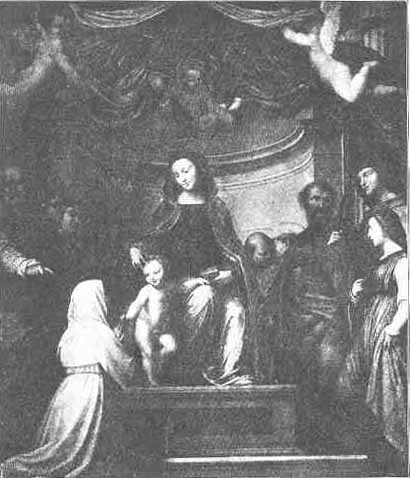 |
| THE MARRIAGE OF ST. CATHARINE. By Fra Bartolommeo, 1475-1517. (Louvre.) Because of the nun's habit this can only be Catharine of Siena. |
The more liberal we grow, the less shall we scorn such art productions from the religious standpoint, for we have acquired breadth enough to find in them the expression of a tender and
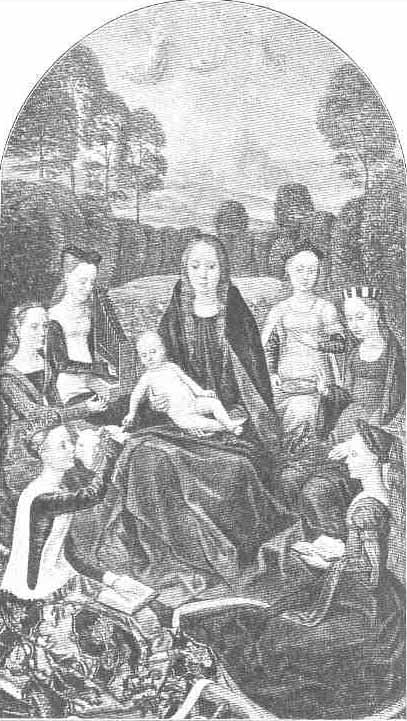 |
| By Hans Memling, d. 1494. (Louvre.) St. Barbara is represented with a book, and in the background are Cecilia, Agnes and other saints. |
p. 461 poetical sentiment that is frequently absent in the cold and unimaginative rationalism of the Reformation.
Unquestionably St. Catharine has been selected as the bride of Christ on account of her name, for the idea of the bridal relation between the Saviour and the saved soul is not so unusual as it might appear to a later born generation, whose interest in fantastic
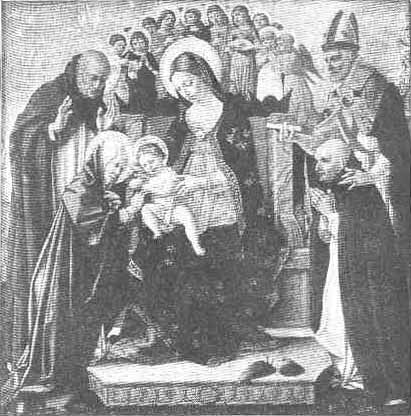 |
| ST. CATHARINE OF SIENA. |
| By Lorenzo da San Severino (latter half of the 15th cent.) On the nimbus around the head of the kneeling St. Catharine are the words "Santa Katrina de Sene." Other saints in the picture are Dominic, Augustine, and Demetrius of Spoleto. |
imagery has considerably waned. Not only is the Church regarded as the bride of Christ, but every nun as well, and in the history of Israel the relation of God to his people is conceived under the same allegory.
The analogy between the nun's vow and the marriage of a p. 462 bride is obvious in many details of the ritual, and the same interpretation was not absent in pagan antiquity where, for instance, the vestal virgins were regarded as matrons and wore six braids, the characteristic hair dress of brides and married women.
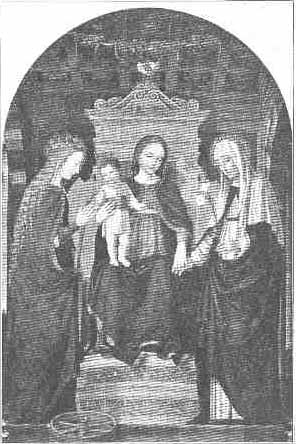 |
| MARRIAGE OF THE CATHARINES. |
| By Borgognone, d. c. 1524. (National Gallery, London.) The infant Christ holds a ring in each hand and while placing one on the finger of Catharine of Alexandria extends the other ring towards the nun, Catharine of Siena. |
In the "Common Office for a Virgin and Martyr," the First Responsory reads as follows in the English version of the Roman Catholic Breviary:
"Come, Bride of Christ, and take the everlasting crown, which the Lord hath prepared for thee, even for thee who for the love p. 463 of Him hast shed thy blood, and art entered with angels into His Garden.
"Come, O My chosen one, and I will establish My throne in thee, for the King hath greatly desired thy beauty.
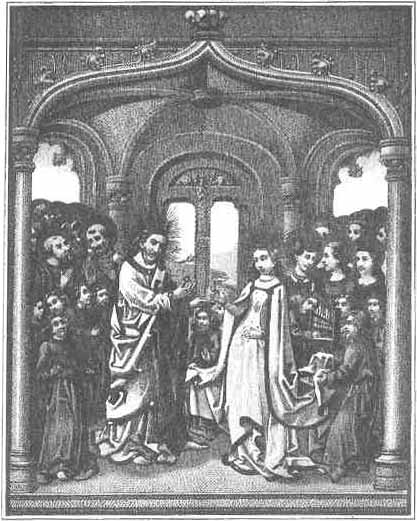 |
| THE MARRIAGE OF ST. CATHARINE. From the illumined text of Mielot's Vie de Ste. Catherine, as revised and modernized by M. Sepet. |
"And thou art entered with Angels into His garden."
There are quite a number of saints that bear the name Catharine, p. 464 but the bride of Christ was originally St. Catharine of Alexandria. Among other saints of the same name the best known is St. Catharine of Siena, and since the people of Siena did not want to stay behind the Alexaridrians, they too claimed for their saint the honor of a mystic marriage with Christ which has been duly represented in the pictures of the saint's life.
The popularity of St. Catharine is proved by the frequent occurrence of the name and also by the belief that she belongs to the most powerful intercessors with God. It will be remembered that Jeanne d'Arc believed that she was especially supported by the Virgin Mary, the Archangel Michael and the two saints Margaret and Catharine. Jeanne d'Arc is reported as having obtained the miraculous sword which she used in battle from St. Catharine's chapel at Fierbois, after receiving a divine revelation that it was hidden there.
Journals Christian Articles St. Catharine of Alexandria
1 See Radau, "Bel, the Christ of Ancient Times" in The Monist, Vol. XIV, pp. 67-119.
2 See also Luke xii. 35, 36.
3 The parallel passages are Matt. ix. 15. and Luke v. 34.
4 Die Keilinschriften und das Alte Testament, pp. 374.
5 Schrader, ibid.
6 Compare also verses 9 and 17.